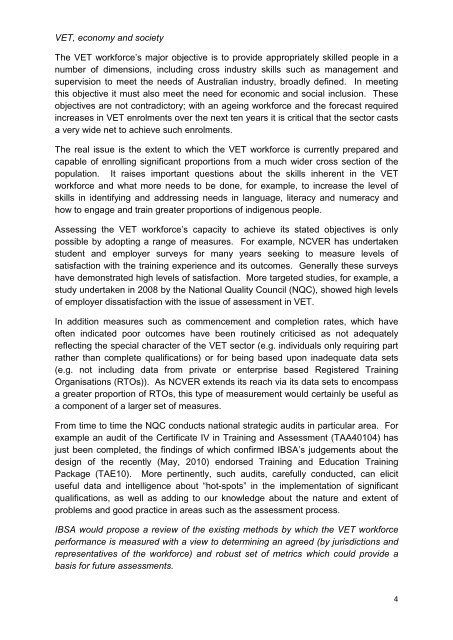Innovation & Business Skills Australia - Productivity Commission
Innovation & Business Skills Australia - Productivity Commission
Innovation & Business Skills Australia - Productivity Commission
Create successful ePaper yourself
Turn your PDF publications into a flip-book with our unique Google optimized e-Paper software.
VET, economy and society<br />
The VET workforce’s major objective is to provide appropriately skilled people in a<br />
number of dimensions, including cross industry skills such as management and<br />
supervision to meet the needs of <strong>Australia</strong>n industry, broadly defined. In meeting<br />
this objective it must also meet the need for economic and social inclusion. These<br />
objectives are not contradictory; with an ageing workforce and the forecast required<br />
increases in VET enrolments over the next ten years it is critical that the sector casts<br />
a very wide net to achieve such enrolments.<br />
The real issue is the extent to which the VET workforce is currently prepared and<br />
capable of enrolling significant proportions from a much wider cross section of the<br />
population. It raises important questions about the skills inherent in the VET<br />
workforce and what more needs to be done, for example, to increase the level of<br />
skills in identifying and addressing needs in language, literacy and numeracy and<br />
how to engage and train greater proportions of indigenous people.<br />
Assessing the VET workforce’s capacity to achieve its stated objectives is only<br />
possible by adopting a range of measures. For example, NCVER has undertaken<br />
student and employer surveys for many years seeking to measure levels of<br />
satisfaction with the training experience and its outcomes. Generally these surveys<br />
have demonstrated high levels of satisfaction. More targeted studies, for example, a<br />
study undertaken in 2008 by the National Quality Council (NQC), showed high levels<br />
of employer dissatisfaction with the issue of assessment in VET.<br />
In addition measures such as commencement and completion rates, which have<br />
often indicated poor outcomes have been routinely criticised as not adequately<br />
reflecting the special character of the VET sector (e.g. individuals only requiring part<br />
rather than complete qualifications) or for being based upon inadequate data sets<br />
(e.g. not including data from private or enterprise based Registered Training<br />
Organisations (RTOs)). As NCVER extends its reach via its data sets to encompass<br />
a greater proportion of RTOs, this type of measurement would certainly be useful as<br />
a component of a larger set of measures.<br />
From time to time the NQC conducts national strategic audits in particular area. For<br />
example an audit of the Certificate IV in Training and Assessment (TAA40104) has<br />
just been completed, the findings of which confirmed IBSA’s judgements about the<br />
design of the recently (May, 2010) endorsed Training and Education Training<br />
Package (TAE10). More pertinently, such audits, carefully conducted, can elicit<br />
useful data and intelligence about “hot-spots” in the implementation of significant<br />
qualifications, as well as adding to our knowledge about the nature and extent of<br />
problems and good practice in areas such as the assessment process.<br />
IBSA would propose a review of the existing methods by which the VET workforce<br />
performance is measured with a view to determining an agreed (by jurisdictions and<br />
representatives of the workforce) and robust set of metrics which could provide a<br />
basis for future assessments.<br />
4

















